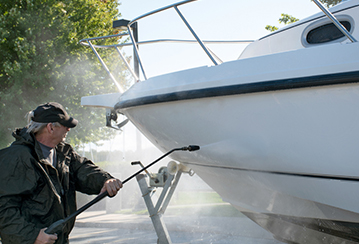Winter can be harsh on a boat, and if you want to get out on the water next spring without any unwelcome surprises, it’s important to store it properly. Not only will cold water and ice cause expensive damage, improperly storing your boat can also leave it vulnerable to theft or damage from a storm.
Boats aren’t cheap to fix either – with the addition of more specialized technology such as navigation devices, cameras, sensors, auto docking features and more, boats are becoming increasingly expensive and complex to repair. That’s why it’s more important than ever to make sure you store your boat properly and regularly perform preventative maintenance. For example, not winterizing an engine can lead to freezing or cracking that costs upwards of $10,000 to repair!1
Follow these tips to keep your boat protected this winter.
-
Inspect your boat and get it serviced. Before you take your boat out of the water, run it one last time and pay attention to anything that might need to be repaired. Winter is the ideal time to get your boat serviced as you won’t lose any time on the water. One item you need to check annually is the rubber seals on the bellows. If those seals wear out, it can lead to partial or total sinking of the boat.1
-
Take your boat out of the water. Never leave your boat in the water during the winter – not only will cold water and ice damage the boat, it also leaves your boat vulnerable to winter storms. If you are storing your boat outside, make sure it’s level when you store it, so the hull doesn’t get warped. Don’t store under trees as a falling branch could damage your boat.
-
Clean your boat. Before you put your boat away, clean it from top to bottom with soap and water. Remove any plant life that’s attached itself to your hull and clean out all cupboards, fridges and drawers. After it’s dry, be sure to wax the hull to keep it in tip top shape. 
-
Drain and winterize your boat. Draining and winterizing your boat prevents any liquid from freezing and breaking parts of your boat. Drain all water from your water tanks, ballast tanks, fuel lines, pipes, and anywhere else there’s water. Properly winterize your engine as well as per the directions in your owner’s manual.
-
Secure all items and seal your boat. Remove any valuable items from your boat, including electronic guidance systems if possible, to protect them from extreme weather and theft. You should also remove anything that could be prone to mildew and mold over the winter, such as flotation devices. Once you’ve removed all loose items, wrap the boat using boat wrap and cover it with a custom waterproof cover that fits snuggly. If the cover is too loose and saggy, water can collect in parts and damage the cover. Even if you’re storing your boat inside, a cover can protect it from unexpected roof leaks. To prevent pests from making a home in your boat, seal any exhaust ports as well. If you’re storing your boat on its trailer, be sure to lock the tailer and remove the tires so a thief can’t easily drive away with it.
-
Check on your boat regularly. Throughout the winter, check on your boat to make sure there is no damage to the cover and that it is free of pests. Brush off any snow that collects on the cover as well. Once a month, take the cover off and inspect the boat for anything that is amiss.
-
Tell your insurer of your storage plans. Although you may not be using your boat in the winter, you need insurance coverage year-round so that you’re protected from damage to your boat or extreme theft. Your insurer will also need to know your storage plans for your boat to appropriately assess your coverage needs.